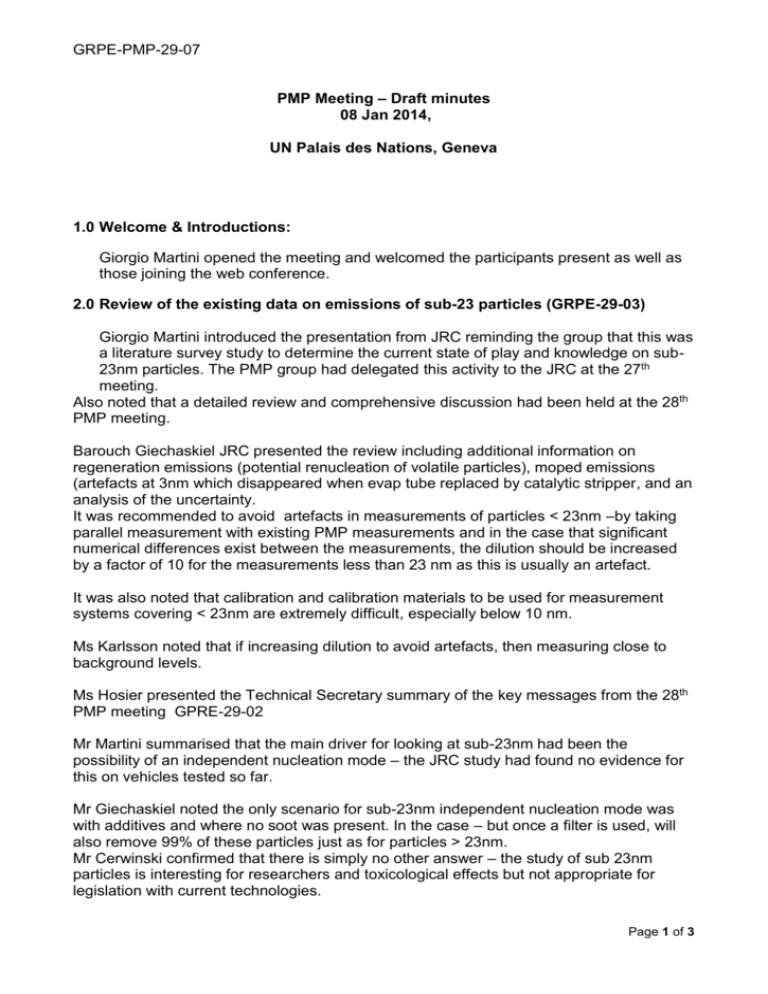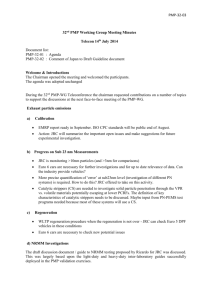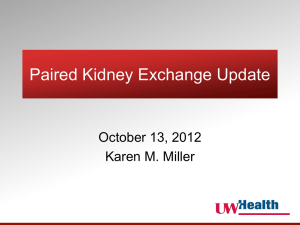GRPE-PMP-29-07 - Jan 2014 draft
advertisement

GRPE-PMP-29-07 PMP Meeting – Draft minutes 08 Jan 2014, UN Palais des Nations, Geneva 1.0 Welcome & Introductions: Giorgio Martini opened the meeting and welcomed the participants present as well as those joining the web conference. 2.0 Review of the existing data on emissions of sub-23 particles (GRPE-29-03) Giorgio Martini introduced the presentation from JRC reminding the group that this was a literature survey study to determine the current state of play and knowledge on sub23nm particles. The PMP group had delegated this activity to the JRC at the 27th meeting. Also noted that a detailed review and comprehensive discussion had been held at the 28th PMP meeting. Barouch Giechaskiel JRC presented the review including additional information on regeneration emissions (potential renucleation of volatile particles), moped emissions (artefacts at 3nm which disappeared when evap tube replaced by catalytic stripper, and an analysis of the uncertainty. It was recommended to avoid artefacts in measurements of particles < 23nm –by taking parallel measurement with existing PMP measurements and in the case that significant numerical differences exist between the measurements, the dilution should be increased by a factor of 10 for the measurements less than 23 nm as this is usually an artefact. It was also noted that calibration and calibration materials to be used for measurement systems covering < 23nm are extremely difficult, especially below 10 nm. Ms Karlsson noted that if increasing dilution to avoid artefacts, then measuring close to background levels. Ms Hosier presented the Technical Secretary summary of the key messages from the 28th PMP meeting GPRE-29-02 Mr Martini summarised that the main driver for looking at sub-23nm had been the possibility of an independent nucleation mode – the JRC study had found no evidence for this on vehicles tested so far. Mr Giechaskiel noted the only scenario for sub-23nm independent nucleation mode was with additives and where no soot was present. In the case – but once a filter is used, will also remove 99% of these particles just as for particles > 23nm. Mr Cerwinski confirmed that there is simply no other answer – the study of sub 23nm particles is interesting for researchers and toxicological effects but not appropriate for legislation with current technologies. Page 1 of 3 GRPE-PMP-29-07 Mr Steininger noted that whilst there was no urgent need, it was important for the European Commission that the PMP group should continue to develop a robust method for measuring sub-23nm in case it became necessary to measure / regulate such particles in future. JRC confirmed this was not a short lead time action and the group accepted the request from the European Commission to continue this work and to develop clear guidelines for avoidance of artefacts during sub-23nm measurements and to better allow comparison between different studies As a consequence of this decision on sub-23nm that it is not an urgent need to revise the measurement method, it was noted that the PMP group should resume consideration of particle number measurement during light duty particle filter active regenerations Agreed to present this issue for GRPE with a slightly modified version of PMP-29-02 rev 1 3.0 Tyre/Road and Brake wear literature study Giorgio Martini reminded the PMP group that there was a specific request from EU Com to address non-exhaust emissions also due to GRPE documents from Russia. PMP agreed to start with a literature review, following which PMP could then decide whether to go forward, stop or assign to another group. Document PMP-29-04 (WBCSD tires) was presented. The European Commission noted that they are more interested in the PN metric rather than PM / PM10. Questions on resuspension of tyre/road wear particles were also raised. WBCSD noted that nano-particles were considered in their study – none were detected either for summer or winter tyres. The measurement system had been challenged with nano-particles to ensure that if present, they would have been detected. The chairman asked whether the particles were mainly tyre, or road or a combination of tyre/road composition. Clarified that the main part of the particles is composed of a tyre/road combination. Document PMP-29-05 - the updated JRC non-exhaust particle literature survey was presented by Mr Grigoratos. New findings were that increasing vehicle speeds have a tendency to shift the size distribution to smaller sizes. Different studies have different results – very difficult to compare owing to different methodologies and measurement conditions as well as lack of a clear definition of ‘normal driving’ There was some brief discussion of potential tyre wear abatement measures but no clear conclusions. The chairman presented a summary of the open questions (PMP-29-06) which the group agreed to present to GRPE. Page 2 of 3 GRPE-PMP-29-07 4.0 Any Other Business Next meetings Arrangements for the next meetings: - Agreed that a doodle poll would be launched to establish the next meeting date (Feb / Mar 2014). Page 3 of 3










